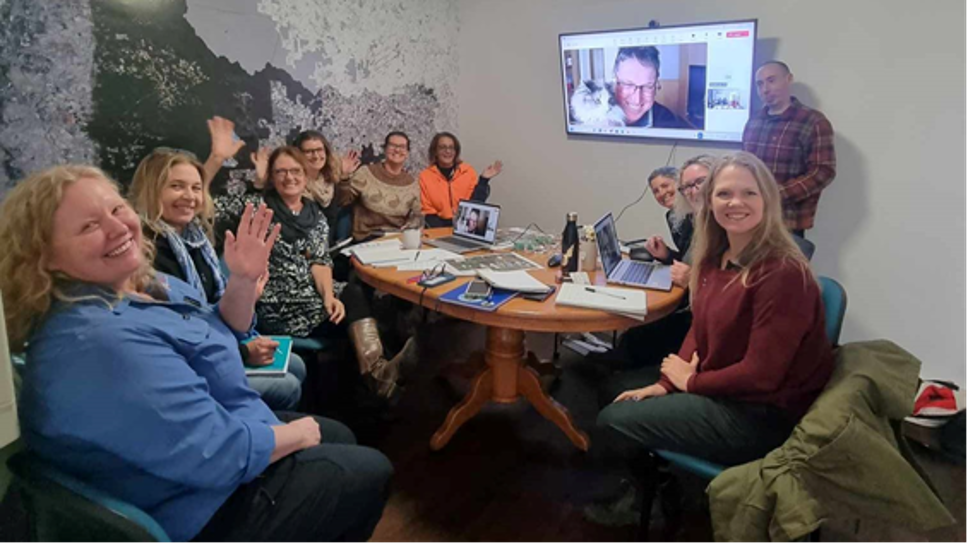
Work is underway to restore a large parcel of Crown Land in Baldivis. Works to be undertaken include River Restoration, water treatment and control, revegetation, pest and weed control as well as monitoring.
The 240ha area of land, east of Kwinana Freeway and south of Karnup Road, is a mixture of Threatened Ecological Communities (Flora and Fauna), Conservation Category Wetlands, constructed wetlands, former grazing land and drainage channels. These are located in a landscape which is recovering from past land management and drainage activities as well as the impacts of Climate Change. The area has many Conservation Category Wetlands and is simply crying-out for support with a very high chance of recovery. Plans include restoring a section of the Serpentine Drain to provide deep pools and refuge habitat for fauna.
In 2025, PHCC was awarded almost $2m, over a period of 3 years, to improve the ecological health and condition of the area through the Australian Government’s Urban Rivers and Catchments Program. PHCC, guided by our Urban Rivers Team, is involving Stakeholders from State and Local Government, Indigenous Rangers and Elders in the proposed works. Crucial to the success of the project is the key involvement of Water Corporation, Department of Water and Environmental Regulation and Department of Biodiversity, Conservation and Attractions. .
These works all impact flows into the Peel-Harvey Estuary and the improvements gained in this project will assist the water quality in the Ramsar 482 area.
The Serpentine River (or under its Indigenous name “Waangaamaap Bilya”) catchment, was brought under European settlement from the 1890’s. A series of very heavy rainfall years in the late 1910’s and early 1920’s, caused large areas of inundation and made the land unworkable for farming. That instigated the government of the time to undertake major drainage works that drained much of the Serpentine River catchment from Cockburn and Byford in the north to Nambeelup in the south. The drainage removed much of the inundation from the farmland, but had the detrimental impact of draining wetlands and much of the landscape of groundwater; with much of that water now being discharged into the Peel-Harvey Estuary. Climate change has exacerbated the problem with “step-change” reductions in rainfall (and flow) occurring in about years 1970 and 2000 with rainfall reductions totalling 23% of pre-1970 rainfall in the catchment. At the latter time, Serpentine River changed from a perennial river (only drying in the most severe droughts) to a seasonally inundated river with long dry periods of 3-4 months each year. This impact of also felt by the many wetlands of the Swan Coastal Plain which also struggle with low water levels and high concentrations of nutrients and salinity.
PHCC and many of our science-based partners believe that these changes can be mitigated and turned around. Yes, the summer-autumn period is very dry and is likely to continue to be so. However, Serpentine River flows discharging to the estuary average over 30GL per year (since 2010). If even a small proportion of that can be retained in our wetlands or riverine pools, that will be a big bonus for the environment!

Serpentine River at Peel Main Drain (PMD) confluence [29/07/2025]

Serpentine Wetland (Conservation Category Wetland) when full [PMD018 – 12-08-2025]

Same Serpentine wetland when almost dry [PMD018 – 20-05-2025]
This funding is hopefully the first step in a longer-term project to undertake restoration of the local environment and its community, flora and fauna. The project includes the following components:
- Undertake River Restoration on sections of the Serpentine River near the Peel Main Drain (PMD) confluence; works will include deepening the river pools to connect groundwater, provide perennial habitat for indigenous fauna in logs and other large woody debris, replant local flora and protect the Banksia Woodland Threatened Ecological Communities (TEC’s) on the river banks and the vulnerable Carter’s Freshwater Mussel which lives in the riverine pools.
- Enhance the heavily degraded Conservation Category Wetlands (CCWs) of the original Serpentine River channel that existed before the river was drained and contained within embankments. These CCW’s have a lineal length of 4km with vegetation that is severely under threat from lack of water over summer. On the higher ground adjacent to these CCW’s are Herb-rich Shrubland TEC’s that are also under threat. Both of these assets are affected from reduced available water due to drainage of the local catchment that is encouraged to flow out to Peel MD and Serpentine River.
- Enhance the operation of the Peel Main Drain (PMD)-Swales operation. The Australian Government Urban Rivers and Catchments Program funding will be used to extend on previous trials to treat high concentrations of phosphorous coming into the PMD-Swales system from the drains, rivers and wetlands in the area. These swales are engineered structures that have been previously constructed from State funding to divert water from the PMD through a set of 6 large channels (Swales) to reduce the amount of Phosphorous in the water column. Funding for their construction was provided by Regional Estuaries Initiative in Royalties for Regions, and the PMD-Swales system has been in operation for the past 3 years with the incremental learnings from each year’s monitoring being fed into annual upgraded designs to build on our understandings. The overall aim is to be able to implement our findings of how best to treat high nutrient inflows and improve the ecological health of the rivers and wetlands in the area.
Outside the project area is the Peel-Harvey Estuary which includes the Ramsar 482 system. All of our work in the Waangaamap Bilya is also aimed at improving the Health of the Estuary.
Keep an eye out for regular project updates in future editions of Wattle & Quoll. There is an update on the Peel Main Drain Swales Off-line Treatment Project in this edition.
This project is funded by the Australian Government’s Natural Heritage Trust under the Urban Rivers and Catchments Program, with the support of PHCC and the Department of Water and Environmental Regulation’s
